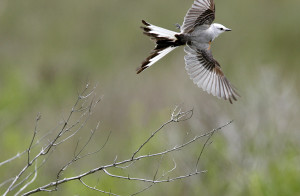Big Slough is the most accessible area of the refuge, with a Discovery Center, short hiking trails and a gravel car trail that winds 7.5 miles around five ponds – at least when there is enough rain. With drier weather, Gator Nest Pond becomes a mudflat, Olney Pond more of a marsh and Rogers Pond a dry bed.
The refuge lies at the end of the Central Flyway for waterfowl in winter and is a stopover for neotropical migratory songbirds at the end of their flight from Mexico’s Yucatan Peninsula. In the summer, the refuge hosts 10 species of herons and egrets.
More than 270 species of birds visit the refuge, along with myriad other wildlife. Rachel Jenkins describes its diverse inhabitants for the Texas State Historical Association:
The upland prairies support wildlife including sandhill cranes, coyotes, and bobcats, and the shore area hosts herons, sandpipers, avocets and stilts. More uncommon marsh and water birds, including roseate spoonbills, double-crested cormorants, and yellow rails, make seasonal appearances, and the endangered American peregrine falcon has occasionally been seen there…. During the winter months duck and goose populations reach peaks as high as 30,000 and 40,000, respectively, and birders at the Audubon Society’s December Freeport Christmas Bird Count often identify more than 200 different bird species, one of the highest counts in the country, in the vicinity of the refuge.
Discovery Center and boardwalk. A maze of boardwalks and observation decks crosses over Big Slough and its islands and seas of bullrushes and cattails. Waterfowl feed among the reeds, and there is usually a gator or two lurking somewhere nearby. The Discovery Center is open intermittently when volunteers are available.
Big Slough Trail. A short distance from the end of the boardwalk the Big Slough Trail begins. The complete loop is 0.6 mile, but there are several cutoffs that make it shorter. The wide, grassy trail parallels Big Slough and ends at another boardwalk overlook. In the summer, the mosquitoes can be insufferable.
Big Slough Car Trail. The Big Slough Auto Tour wraps around Gator Nest, Olney, Cross Trails and Teal ponds with an extension to a lookout and trailhead at Rogers Pond. The landscape varies considerably depending on recent rainfall. You’ll see flocks of White Ibis, Roseate Spoonbills, Avocets, Stilts and other wading birds and, in the winter, thousands of ducks and geese.
REFUGE GALLERY













You must be logged in to post a comment.